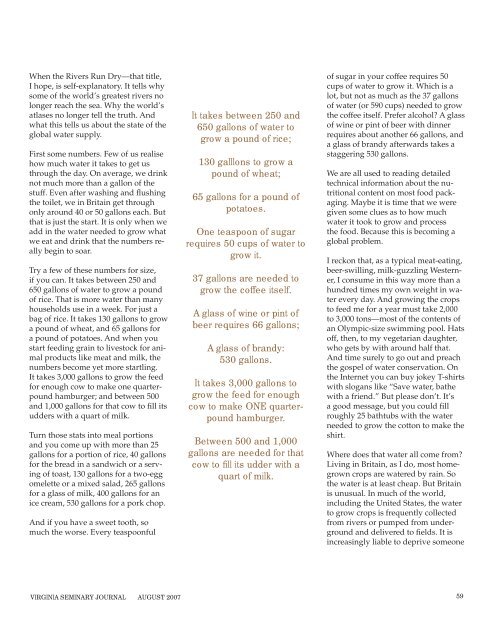Seminary Journal 2008 (August) - Virginia Theological Seminary
Seminary Journal 2008 (August) - Virginia Theological Seminary
Seminary Journal 2008 (August) - Virginia Theological Seminary
Create successful ePaper yourself
Turn your PDF publications into a flip-book with our unique Google optimized e-Paper software.
When the Rivers Run Dry—that title,<br />
I hope, is self-explanatory. It tells why<br />
some of the world’s greatest rivers no<br />
longer reach the sea. Why the world’s<br />
atlases no longer tell the truth. And<br />
what this tells us about the state of the<br />
global water supply.<br />
First some numbers. Few of us realise<br />
how much water it takes to get us<br />
through the day. On average, we drink<br />
not much more than a gallon of the<br />
stuff. Even after washing and fl ushing<br />
the toilet, we in Britain get through<br />
only around 40 or 50 gallons each. But<br />
that is just the start. It is only when we<br />
add in the water needed to grow what<br />
we eat and drink that the numbers really<br />
begin to soar.<br />
Try a few of these numbers for size,<br />
if you can. It takes between 250 and<br />
650 gallons of water to grow a pound<br />
of rice. That is more water than many<br />
households use in a week. For just a<br />
bag of rice. It takes 130 gallons to grow<br />
a pound of wheat, and 65 gallons for<br />
a pound of potatoes. And when you<br />
start feeding grain to livestock for animal<br />
products like meat and milk, the<br />
numbers become yet more startling.<br />
It takes 3,000 gallons to grow the feed<br />
for enough cow to make one quarterpound<br />
hamburger; and between 500<br />
and 1,000 gallons for that cow to fi ll its<br />
udders with a quart of milk.<br />
Turn those stats into meal portions<br />
and you come up with more than 25<br />
gallons for a portion of rice, 40 gallons<br />
for the bread in a sandwich or a serving<br />
of toast, 130 gallons for a two-egg<br />
omelette or a mixed salad, 265 gallons<br />
for a glass of milk, 400 gallons for an<br />
ice cream, 530 gallons for a pork chop.<br />
And if you have a sweet tooth, so<br />
much the worse. Every teaspoonful<br />
VIRGINIA SEMINARY JOURNAL AUGUST 2007<br />
It takes between 250 and<br />
650 gallons of water to<br />
grow a pound of rice;<br />
130 galllons to grow a<br />
pound of wheat;<br />
65 gallons for a pound of<br />
potatoes.<br />
One teaspoon of sugar<br />
requires 50 cups of water to<br />
grow it.<br />
37 gallons are needed to<br />
grow the coffee itself.<br />
A glass of wine or pint of<br />
beer requires 66 gallons;<br />
A glass of brandy:<br />
530 gallons.<br />
It takes 3,000 gallons to<br />
grow the feed for enough<br />
cow to make ONE quarterpound<br />
hamburger.<br />
Between 500 and 1,000<br />
gallons are needed for that<br />
cow to fi ll its udder with a<br />
quart of milk.<br />
of sugar in your coffee requires 50<br />
cups of water to grow it. Which is a<br />
lot, but not as much as the 37 gallons<br />
of water (or 590 cups) needed to grow<br />
the coffee itself. Prefer alcohol? A glass<br />
of wine or pint of beer with dinner<br />
requires about another 66 gallons, and<br />
a glass of brandy afterwards takes a<br />
staggering 530 gallons.<br />
We are all used to reading detailed<br />
technical information about the nutritional<br />
content on most food packaging.<br />
Maybe it is time that we were<br />
given some clues as to how much<br />
water it took to grow and process<br />
the food. Because this is becoming a<br />
global problem.<br />
I reckon that, as a typical meat-eating,<br />
beer-swilling, milk-guzzling Westerner,<br />
I consume in this way more than a<br />
hundred times my own weight in water<br />
every day. And growing the crops<br />
to feed me for a year must take 2,000<br />
to 3,000 tons—most of the contents of<br />
an Olympic-size swimming pool. Hats<br />
off, then, to my vegetarian daughter,<br />
who gets by with around half that.<br />
And time surely to go out and preach<br />
the gospel of water conservation. On<br />
the Internet you can buy jokey T-shirts<br />
with slogans like “Save water, bathe<br />
with a friend.” But please don’t. It’s<br />
a good message, but you could fi ll<br />
roughly 25 bathtubs with the water<br />
needed to grow the cotton to make the<br />
shirt.<br />
Where does that water all come from?<br />
Living in Britain, as I do, most homegrown<br />
crops are watered by rain. So<br />
the water is at least cheap. But Britain<br />
is unusual. In much of the world,<br />
including the United States, the water<br />
to grow crops is frequently collected<br />
from rivers or pumped from underground<br />
and delivered to fi elds. It is<br />
increasingly liable to deprive someone<br />
59



